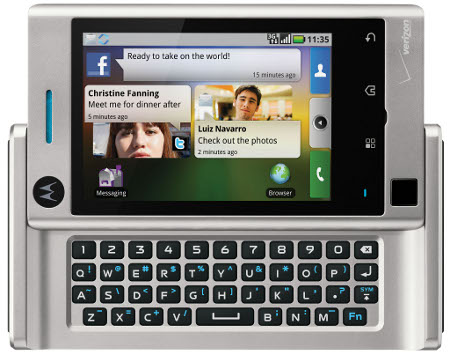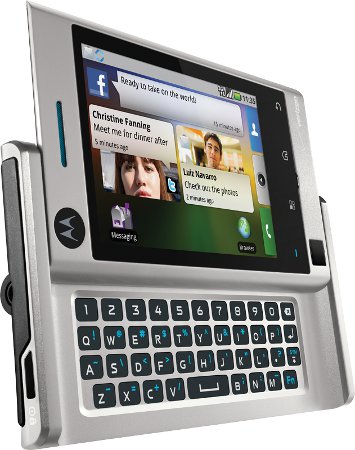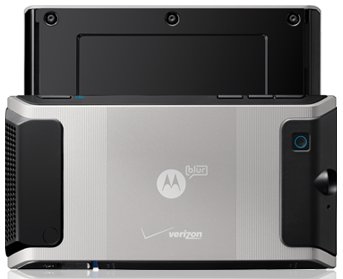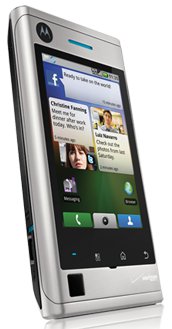Android phone brings MotoBlur UI to Verizon
Feb 3, 2010 — by Eric Brown — from the LinuxDevices Archive — 1 viewsMotorola and Verizon Wireless announced a mid-range Android phone sporting the former's MotoBlur UI. Due for a March launch, the “Devour” offers a 3.1-inch HVGA capacitive touchscreen, a side-slider keyboard, three-megapixel camera, CDMA/EVDO 3G, WiFi, Bluetooth, GPS, and a full complement of apps, including Google Maps Navigation, says Motorola.
The Devour is Verizon's third Android phone, the first not to include "Droid" in its name, and the first to offer Motorola's MotoBlur UI layer. The phone is Motorola's fifth Android phone after the Cliq (T-Mobile), Droid (Verizon), Backflip (reportedly heading for AT&T), and the Motoroi (SK Telecom in Korea).
The Devour was tipped back in October along with another rumored low-end Mot phone, the ribbed-grip, China-destined Zeppelin. Although not quite as basic as Mot's rumored GSM-based "Ruth" (or "MB511") phone, the Devour (also previously known as the "Calgary") is closer to its fellow MotoBlur-based phones, the Cliq and the Backflip, than it is to the Droid.

Motorola Devour
(Click to enlarge)
Motorola does not list the processor on the Devour web-page, but PhoneNews located some support documentation that, it says, lists a 600MHz Qualcomm MSM7627 processor. This CPU is the same as that used by the Palm Pixi, and roughly equivalent to the Droid Eris' 528MHz Qualcomm MSM7600 processor. The site also lists 256MB RAM and 512MB internal flash memory.
Other specs are posted openly by Motorola on the official Devour page, including the presence of an 8GB microSD card, expandable to 32GB (as opposed to 16GB for the Eris). The Devour offers a 3.1-inch, 320 x 480 capacitive touchscreen, slightly smaller than the Eris' 3.2-inch model, and features a three-megapixel camera, compared to the Eris' five-megapixel camera. Other features appear to be similar, including CDMA/EVDO 3G, WiFi, Bluetooth, GPS.

Motorola Devour from an angle
(Click to enlarge)
The Eris stands out, however, with its better camera, and the fact that it is slightly smaller and lighter than the Devour, which measures 2.4 x 4.5 x 0.6 inches and weighs 5.9 ounces. The relatively high weight count may be due in part to the extruded aluminum exterior design.
The Devour's MotoBlur UI layer works closely with a MotoBlur "push" web service, which streams integrated messaging and social networking updates data to the user. This widget-happy interface integrates communications ranging from email to social networking activity, streaming together and syncing updates to contacts, posts, messages, photos, and data.

Devour from the back
Other applications include the WebKit browser with Adobe Flash Lite, as well as a full slate of Google Apps, including the top-notch Google Maps Navigation, says Mot. The phone also offers access to Android Market, which is now said to house more than 20,000 apps.
As with the Backflip, Motorola lets users access the phone over the web, enabling them to erase all data in case the phone is lost, stolen, or otherwise devoured. Users can also locate the Devour (pictured below at right) via GPS, says Motorola, and the user name and password can also be restored remotely. 
Specifications listed by Motorola for the Devour include:
- Flash — 8GB microSD pre-installed, expandable to 32GB
- Display — 3.1-inch HVGA (320 x 480) capacitive touchscreen
- Input — Side-slider keyboard; touchpad; accelerometer
- Cellular — CDMA 800/1900 EVDO rev A
- WiFi — 802.11b/g
- Bluetooth — Stereo Class 2 + EDR (supports A2DP, HSP, HFP)
- GPS — aGPS
- USB — USB 2.0 High Speed micro-USB port
- Camera - 3-megapixel with continuous zoom; video capture up to 23fps
- Audio — 3.5mm headset jack
- Software features (partial list):
- MotoBlur with phonebook sync
- Gmail, Google Talk, YouTube, Google Search, Google Maps with Google Maps Navigation
- Image editing tools and photo sharing with Facebook, etc.
- Audio and video players
- Android HTML Webkit browser with Adobe Flash Lite
- Email, IM, SMS
- Verizon V CAST Music with Rhapsody, Visual Voice Mail, V CAST Video, VZ Navigator
- DLNA support
- Battery — 1400 mAh Li Ion with up to 389 continuous minutes (standby up to 443 hours)
- Weight — 5.9 oz. (180 g)
- Dimensions — 2.4 x 4.5 x 0.6 inches (61.0 x 115.5 x 15.4mm)
- Operating system — Android 1.6
Availability
The Devour will go on sale at Verizon Wireless in March, says Motorola. The companies did not mention pricing.
More information may be found at Motorola Devour web-page, here. Support documents for the phone are available here. The PhoneNews item on the phone may be found here.
This article was originally published on LinuxDevices.com and has been donated to the open source community by QuinStreet Inc. Please visit LinuxToday.com for up-to-date news and articles about Linux and open source.